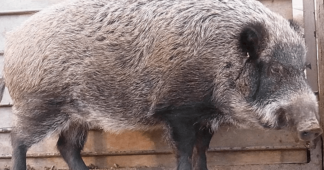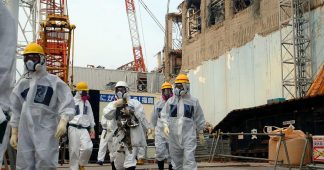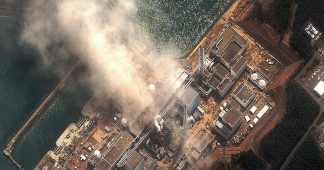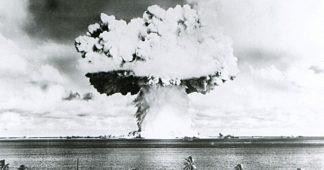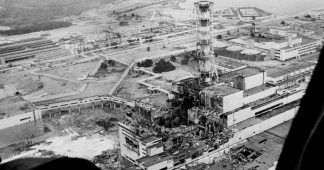March 10, 2022
Kenichi Hasegawa was a dairy farmer in Fukushima Prefecture at the time of the March 11, 2011 Fukushima Daiichi nuclear disaster, living in a family of eight in Itate village with his parents, wife, children and grandchildren.
Iitate is approximately 50 kilometers away from the nuclear site, but quickly became one of the most radioactively contaminated places as a result of the Fukushima disaster. Yet, residents were told little and it took more than a month for an evacuation order to be issued for Itate. Many did not leave until late June.
Mr. Hasegawa himself stayed on in Itate for five months after the disaster, tending to his cows until all of them were put down. Meanwhile, he kept a visual record of conditions there, taking more than ten thousand photos and 180 videos (in Japanese).
On October 22, 2021 Hasegawa died of thyroid cancer at just 68, almost certainly caused by his prolonged exposure to radioactive iodine released by the Fukushima Daiichi nuclear catastrophe.
Before the nuclear disaster, Hasegawa owned 50 dairy cows and farmed vegetables. He was also a political leader, serving as mayor of his local ward. But the Fukushima accident changed everything.
With a high concentration of radioactive substances now found in dairy milk, his business was ruined. Angered by the cover-up by authorities of the true extent of radioactive contamination, he became a co-representative along with Ms. Ruiko Muto, of the Nuclear Accident Victims Group Liaison Committee, established in 2015.
By then, he had already authored the 2012 book, Fukushima’s Stolen Lives: A Dairy Farmer’s Story, in which he delivered an eyewitness account of the aftermath of the nuclear disaster, “as he suffered with the knowledge that his children and grandchildren had been exposed to radiation, as he lost all of his cattle (who were considered part of the family, not simply the source of their livelihood), and as he endured the suicide of a fellow dairy farmer and friend.”
That friend wrote his final words on a wall before he died: “If only there were no nuclear power plants.”
Hasegawa returned to Iitate in 2018, once the evacuation order had been lifted, and began growing buckwheat, largely to prevent his pastures from turning into wasteland. Although radiation levels in the buckwheat registered below what is considered dangerous, Hasegawa could not sell the crop.
In a 2020 interview with his Committee colleague, Ms. Muto, a resident of Miharu town, Hasegawa said: “The nuclear plant robbed us of everything. We still can’t go into the forests. Families with children used to go into the forest to gather wild plants and teach many things. That was a common practice, taken for granted. But today we can’t do anything like that. We can no longer eat anything foraged from the forest.
“In Japan, a community like ours affected by radiation is seen as an inconvenience,” Hasegawa told Muto. “They would like us to disappear and be forgotten.”
Family life was shattered by the Fukushima accident, including Hasegawa’s. His children and grandchildren vowed not to return the village and its contaminated land. In the Maeda neighborhood, where Hasegawa served as mayor, the population is now largely comprised of the elderly.
Worse still, Hasegawa said TEPCO’s approach was to blame the victims, rather than take responsibility for the devastation its nuclear power plant had caused.
“TEPCO eventually said that it’s really the village’s fault that people were exposed to radiation, because they did not evacuate,” Hasegawa recalled to Muto. “But we couldn’t evacuate because we had livestock or other things holding us back. They are saying everything was our own responsibility. Of course I protested loudly. How dare they blame us!”
Hasegawa is sadly, and unsurprisingly, not the only person who has succumbed to a premature death owing to radiation exposure caused by the Fukushima Daiichi nuclear catastrophe. By 2021, friends and colleagues involved with the aftermath of the Fukushima Daiichi disaster could count numerous people who had died.
Yet, even immediately after the still on-going nuclear disaster began, Japan’s Chief Cabinet Secretary said repeatedly: “There is no immediate effect on the human body or health”. The phrase was all too reminiscent of the ironic and prescient warning give to us by radiation researcher, Rosalie Bertell, in her 1985 book, “No Immediate Danger”.
One of those also lost in 2021 was Ms Yayoi Hitomi. She was only 60 years old when she died of ovarian cancer on September 28. Already an anti-nuclear activist well before the Fukushima Daiichi disaster, she was living in Koriyama city, situated just 60km from the stricken plant. Although Koriyama was categorized as outside of the mandatory evacuation zone, it was full of radiation hotspots.
Hitomi was a member of Women of Fukushima Against Nuclear Power. She worked as a journalist and web writer, and was one of the most efficient organizers of the Fukushima Nuclear Criminal Litigation Support Group. After Hitomi’s death, Muto, the head of the plaintiffs’ group, said that it was as if she had lost one of her arms.
Hitomi went to Europe in March 2016, and spoke in several countries on the situation in Fukushima. She was full of energy, and looked no older than 40. However, in the fall of 2016, a cancer was discovered and she passed away five years later. Her death tells us that even if you live outside of the mandatory exclusion zone, you aren’t always protected against potentially lethal radiation health hazards.
These coming losses had been predicted in a March 2020 interview (in Japanese), when Hasegawa and his wife had observed that people in their 50s and 60s were dying like flies.
All of this of course gives the lie to — and makes especially insensitive and abhorrent — claims made by nuclear power boosters, and even lazy journalists, that “no one died because of the Fukushima nuclear accident”.
Kurumi Sugita also contributed to this article.
Headline photo of Kenichi Hasegawa speaking in Australia, by MAPW Australia/Creative Commons
Published at www.counterpunch.org
We remind our readers that publication of articles on our site does not mean that we agree with what is written. Our policy is to publish anything which we consider of interest, so as to assist our readers in forming their opinions. Sometimes we even publish articles with which we totally disagree, since we believe it is important for our readers to be informed on as wide a spectrum of views as possible.
